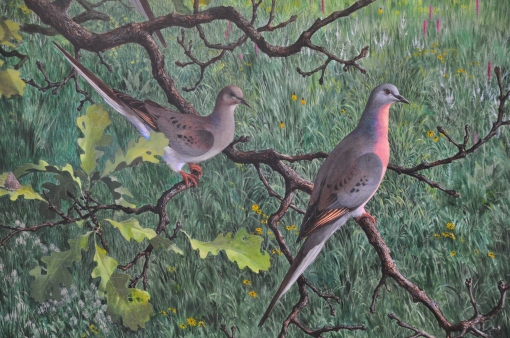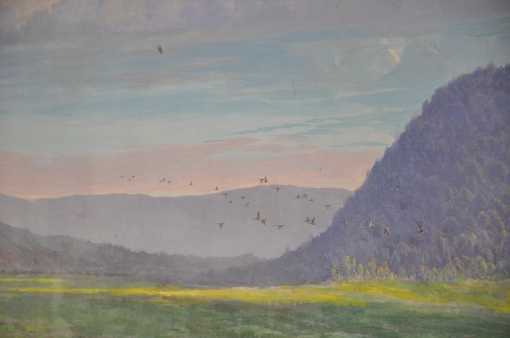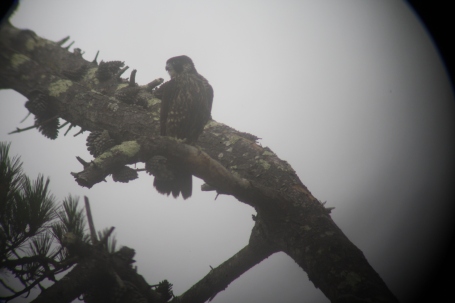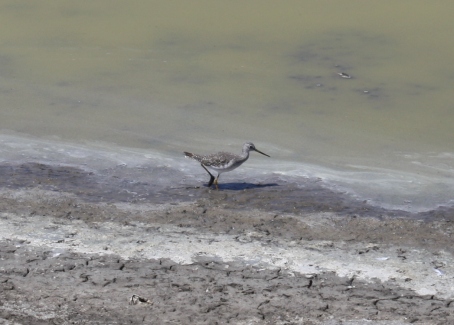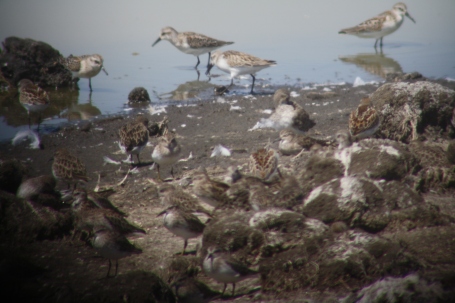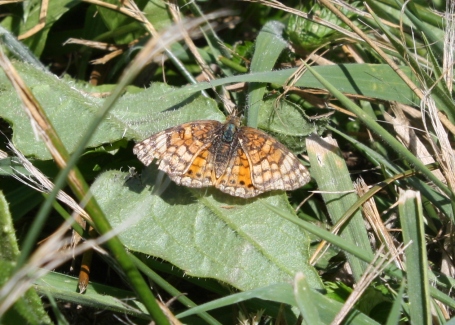Victor Bakhtin landscape painting–almost as good as being there.
Outside the Whooping Crane exhibit here at ICF there is a beautiful landscape mural painted by Victor Bakhtin, the same artist who painted the Platte River mural inside our visitor’s center.
The landscape is located just south of Baraboo, Wisconsin, not too far from the International Crane Foundation. Victor Bakhtin painted it in 1994, but when does it take place? Here are some clues.
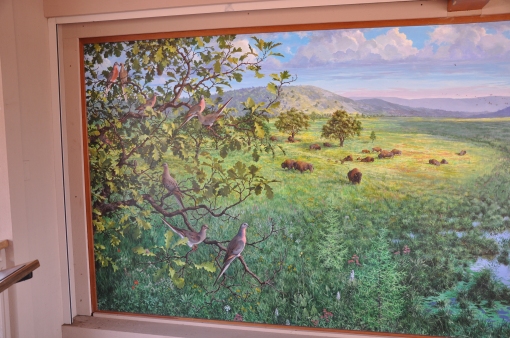
This looks like a tree full of Passenger Pigeons, but my boss says there are also Mourning Doves in there. Here is a website with ID information: http://www.si.edu/encyclopedia_si/nmnh/passpig.htm Anyone care to comment?
According to the Wisconsin Department of Natural Resources, the last two bison east of the Mississippi River were shot in 1832. This scene probably took place at least a century before then. At that time herds of bison roamed the great prairies surrounding Baraboo, and Passenger Pigeons were so plentiful that they could blacken the sky for hours as they migrated in search of acorn masts. Today’s bison herds are a mere shadow of their former greatness, and the Passenger Pigeon is a ghost. As it approached extinction, a few brave conservationists began to call for measures of protection, or for at least some limit to Passenger Pigeon hunting. Their pleas would go unanswered.
In 1857, the Ohio legislature infamously stated: “The Passenger Pigeon needs no protection. Wonderfully prolific, having the vast forests of the North as its breeding grounds, traveling hundreds of miles in search of food, it is here today and elsewhere tomorrow, and no ordinary destruction can lessen them, or be missed from the myriads that are yearly produced.”
By 1900 the last wild Passenger Pigeon in North America was shot by a farm boy in Ohio. In 1914 the last Passenger Pigeon died in the Cincinnati Zoo. She was named Martha, after Martha Washington.
I like to use this mural while giving my talks to discuss the idea of extinction. It shows what our landscape used to look like, and foreshadows the fate of many species on the brink of extinction. The mural is filled with other species that have tenuous futures. At ICF we strive to conserve land and resources not only for cranes, but for other species that share their landscapes. And for us, because a world without biodiversity wouldn’t be worth living in.
Here are some more hidden gems from the mural. Don’t worry, there are still more for you to discover on your own.
Counting Cranes and Booming Cocks
This weekend was very birdful. I think I’m too exhausted to go into great detail, so I’ll try to let the pictures speak for themselves.
Saturday morning I surveyed cranes at Mirror Lake State Park for the Annual Midwest Crane Count. It was my second time at Mirror Lake, and I liked it so much that I went back for a third time today. I was lucky enough to steal my survey area from someone who had other commitments, but she claimed that her crane count survey area was the best in Sauk County, maybe the best in the state of Wisconsin. I believe her. It was gorgeous.
Crane Count was incredible. Not only did I see 17 Sandhill Cranes, I also saw many other bird species, a muskrat, and a beautiful sunrise. I also helped contribute to citizen science. Crane Count data is continuously being compiled to add to our knowledge of crane populationt trends, which determines conservation efforts for North American cranes. This morning I found a second nesting Sandhill Crane at Mirror Lake. What a cool place.
Last night my friend Michelle and I headed to Hartman Creek State Park to camp before seeing the Greater Prairie Chickens leking near Stevens Point, Wisconsin. We had almost the entired campground to ourselves and picked a nice site overlooking a small lake. Before an amazing dinner of instant rice and Indian food, we took a slow walk around the lake. A solitary Canada Goose stood as still as a Ninja on a shoreline log, while ten or so Woodducks made passes through the lake and surrounding pine forest. A Rusty Blackbird male whistled and garbled near our campsite as we ended our short hike. After many s’mores (way too many) a Sora called once from the shoreline. My first of the year.
Four short hours of sleep and we started breaking down camp at 2:30 in the morning. We got to the meet up site near Plover, Wisconsin at 4:30, and set off to start viewing at 5:15. It was worth the earlystart.
In all we saw 15 Greater Prairie Chickens, consisting of 12 booming cocks (yes they are really called that) and 3 hens. The cocks were trying their hardest, leaping into the air, shaking and shimmying around the leking ground, lifting up their “rabbit ear” feathers, and of course, booming. The booming calls were constant for the two hours we were in the blind. Priaire chickens cocks boom by inflating their balloon-like orange air sacs and using them to resonate a low, haunting call The cocks also fought incesisently with each other, cackling and complaining and clawing instead of concentrating on the real prize, the hens. Michelle was lucky enough to witness one copulation, and she even got it on video! I can’t wait to see that. We filled out a survey form for our blind, which is another contribution to citizen science. Call me a nerd, but I love conducting bird surveys.
To say I had fun this weekend would be a huge understatement. It was phenomenal.
Wetland Birding in Lake County, Illinois
On April 10th I met Joel Greenberg at Wadsworth Wetlands for some morning birding. He had a survey to fill out, while I just had time to burn and the itch to see some first-of-the-year birds. Mission: accomplished for both of us.
The early morning air sung as waterfowl whistled through the marsh. Blue-winged Teals were out in fair numbers, with the occasional scattered Green-winged Teal. I love the bright, crisp colors of male waterfowl, and their desperate attempts to round-up less than enthusiastic females. The plants were feeling the drive to reproduce as well. Some spring flowers, namely Blood Root, were blooming, and many plants were starting to show green. Everything right now is twitterpated, and I myself fall in love with the scene around me every spring.
After the bird survey at Wadsworth we decided to hit up some more Lake County birding spots. A trip to a tucked away subdivision yielded my first Rusty Blackbird in the lower 48. Its call conjured up memories of nest searching in Alaska, when I was employed as a Rusty Blackbird field technician in Yukon Flats. It’s funny how a two note call and an electronic garble can open up a flood of memories. It was a happy moment. And I was glad to see at least one Rusty Blackbird on the migration route–it gave me faith that some of them can indeed find stopover sites in Illinois.
Joel pointed out a Beaver lodge that had overflowed onto the walking path. He showed me, through some tugging and pushing, that beavers build their dams by interweaving sticks and branches and packing in mud, making them very difficult to pull apart. Clever little engineers, aren’t they?
Just before we headed back to the car, I snapped a blurry picture of Painted Turtles basking on a log. There were piles of them, like mishappen flap jacks, strewn about the wetland.
The last birding spot was Lake Michigan, where I encountered a FOY Common Loon. It displayed beautiful breeding plumage, but only gave us furtive glances. We stood for a while, hunting it down in a bay area while it spent most of its time hunting underwater. Once Joel and I both got good looks, we decided to call it a day.
As usual, a lot of birding only makes me feel like birding a lot more. Fortunately this works out. In a few days I will be conducting a Crane Count in Sauk County, Wisconsin. Following that experience I will be visiting a Greater Prairie Chicken leking site in Stevens Point, Wisconsin. I can’t wait.
April 7th, 2010: Prairie Dropseed
I took the above picture 2 days after a 30 acre prescribed burn at the International Crane Foundation.
The second picture is one I took today. Less than two weeks post burn and the blackened earth is sprouting green. I was chatting with Shannon, one of the other naturalists here at ICF, and we thought that a lot of the green seen in the above picture may be invasive, cool-season grasses. But the photo posted below is definitely an image of a native prairie plant.
Peeking out from a blackened exterior, signs of spring (even on a dreary day like today). Prairie Dropseed (Sporobalus heterolepis) grows in clumps. One of the ecologists here calls it “Cousin It” grass, because it looks like an Adam’s Family character has been buried in the prairie soil, with just its head sticking out. The recent burn should trigger flowering in this year’s Prairie Dropseed plants, which are apparently very fragrant when in bloom. I’m excited!
I was lucky enough to experience ICF’s “burn school”, a two day course taught by our staff ecologists on the ecology and logistics of using prescribed fire as a restoration tool. Looks like the burn on ICF’s property is already working its magic on the landscape.
March 20th, 2010: Sweet Home Wisconsin
It was my first weekend in Wisconsin, of what will be many to come. I decided to head out to Mirror Lake State Park, and it was the best decision I’ve made all week.
Mirror Lake is located near my new home at the International Crane Foundation in Baraboo, Wisconsin. Although the weather was a bit chilly this morning, the windy was calm, and the lake did indeed look like a Mirror. I stood near the shore at a boat landing. Several waterfowl species broke the glassy mirror of the lake with their paddling, and I managed to get great scope views of 6 species of waterfowl. The highlight was 14 Ring-necked Ducks, all of them bright males except for 2 females. Two brilliant male Buffleheads bobbed in and out of the lake as well. Four Sandhill Cranes circled the lake in the angled morning light, and two settled down near the shoreline. I watched the two that landed preening in unison, making me think they were pair bonding.
Like an idiot I forgot my camera, but I’ll probably throw in a photo of the lake here once I get back. Which will be soon.
I spent the rest of the morning exploring the area around Lake Delton (passing by the upside-down White House in Wisconsin Dells, as well as innumerable water parks, go-cart tracks and one deer park). I added Wood Duck to my Wisconsin list, and I could hear the bugles of Sandhill Cranes almost every time I got out of my car. All in all a very delightful morning. I am so happy that I get to spend my summer in this incredible region.
October 6th, 2009: Recap of Bird-a-thon
It took me a while to write this, and then I forgot about it and forgot ot post it. Here it be!
On September 21st I stepped out with PRBO’s education team for a bird-a-thon fundraiser for our organization. We called ourselves The Indicators. That is another story. This is the story of our big day.
We started out at 6:30 in the morning. When my coworker and I pulled up to the parking lot at the Five Brooks trailhead in Olema Rich Stallcup was already 10 species deep, his scope set up and his ears vibrating with the sounds of a foggy morning on Point Reyes Peninsula. I already knew how big this was going to be. My supervisors soon joined us, and we had started a short walk around the nearby pond. The highlight of Five Brooks was finding the perfect spot where the sun hit the trees. Four warbler species posed in tiny windows, sparkling in the early sunlight. They fed with energy and enthusiasm, and I watched them similarly.
We piled into Rich’s car and hit Bolinas Lagoon and Stinson Beach. A keen eye caught a juvenile Peregrine falcon alight in a tree, and I had my first life-bird of the day, a Clark’s grebe. Rich nabbed our first vagrant—a Western kingbird.
An hour later and we were bouncing down Sir Frances Drake Boulevard toward the outer point. We made a pit stop at Olema Marsh, where Virginia rails and Soras gave themselves up before we could even take out a playback tape. Further down the road a Great horned owl juvenile screeched its begging call to its parents. The fog drip and chill of the morning had it holding out its wings and slumping its shoulders. It looked quite sullen.
At Chimney Rock trailhead Rich teased an American redstart (more like “yellowstart” as it was a first year female) out of the douglas firs. It flicked its fan-tail for us. A somewhat familiar sight for me, but a first for one of my Californian coworkers. A few Barn owls floated in and out of the tree tops, but a bird-a-thon is no time for aesthetics. We jumped back onto the winding road and made our lunch stop at Drake’s Beach. No new birds, but as we ate Rich chummed for a Glaucous-winged gull with french fries. Instead, we were surrounded by hungry and desperate Ring-billed, California and Heerman’s gulls. My coworker Cynthia got some excellent shots out of the group.
Rich aimed us toward north beach on the other side of the peninsula. The Pacific was being fairly torrential, throwing white foam on giggling tourists. Mounted on the sand dune above the parking lot with a carpet of ice plan beneath our feet, we shared two scopes to scan the blue for potential new species. Loons grumbled beneath the surf. Rich laid eyes on a Common murre, and I had my big spot for the day and a life-bird as well—a Pomarine jaeger cutting fast across the distant rolling valleys and troughs. Two Sooty shearwaters disappeared and reappeared beneath the rolling sea as they followed a similar path. Another first for me. I was worried I wouldn’t be able to find them after Rich found them in his scope, but they are absolutely different from anything I have seen before. The brief experience searching for pelagic with Rich made my mouth water for a pelagic trip.
We determined that we had gotten as much as we would get out of the Point Reyes peninsula that day, so we head toward east Marin County for a different suite of bird fauna. At Stafford Lake we found our third and final nuthatch for the day. Rush Creek gave us a flock of feeding Black-necked stilts. But we were slowing down fast. We had started out the day in 53 degree weather, under a cloudy sky and picking up bird species at an exponential rate. Now it was 95 degrees and the bird species were largely repeating themselves. My brain was melting, but Rich seemed to harden his resolve. Probably from years of experience doing bird-a-thons in Marin County and his phenomenal love of nature. He knew there would be more to come.
At Bahia Reserve we found our fourth tern of the day—a Forster’s tern lilting far in the distance spotted by Rich. Missy, one of my supervisors, found a far away American avocet through the spotting scope. A Nuttall’s woodpecker double-called at us, and my doubting Thomas faded away. There is always more to see on a big day. We were at 135 species.
My two supervisors headed home at that point, but Rich said that he thought we could get 10 more species if we hit Las Gallinas sewage treatment plant in San Rafael. Of course, I could not resist. Just a little further was becoming our mantra. We spent about an hour and managed to pull out 11 more species, including all of our swallows for the day (3 species). As we almost hit the parking lot I asked Rich, “What’s that bird in the bush?” referring to a piece of vegetation not 8 feet from us. I thought it was a silly question as I was asking it; it was probably another Say’s phoebe.
“That’s amazing!” he said. “An Ash-throated flycatcher!” Thus bringing our total to 146 species for the day.
I probably could have kept going, but it was a good time to end. Rich had 2 more bird-a-thons to lead that week, so he needed all the rest he could get. I had seen more bird species that day than I ever had in my life.
I had my first bird-a-thon this past spring, and it is fun to compare the two experiences. Rich has been birding Marin County for many years, and he is a dedicated and talented birder. I’m a newb, and when I did my bird-a-thon in the DC area I was in a new area. I got a much lower count on the east coast, but it was still an incredible day. I knew right away after my first bird-a-thon that planning is key, and that comes with experience. I hope that the next bird-a-thon is on familiar ground, and that I will take note of how well Rich planned our bird-a-thon.
And I’m already excited for the next one, wherever that may be.
Final bird list:
| Canada Goose |
| Wood Duck |
| Gadwall |
| American Wigeon |
| Mallard |
| Cinnamon Teal |
| Northern Shoveler |
| Northern Pintail |
| Green-winged Teal |
| Surf Scoter |
| Common Merganser |
| Red-breasted Merganser |
| Ruddy Duck |
| California Quail |
| Red-throated Loon |
| Pacific Loon |
| Common Loon |
| Pied-billed Grebe |
| Eared Grebe |
| Western Grebe |
| Clark’s Grebe |
| Sooty Shearwater |
| American White Pelican |
| Brown Pelican |
| Brandt’s Cormorant |
| Double-crested Cormorant |
| Pelagic Cormorant |
| Great Blue Heron |
| Great Egret |
| Snowy Egret |
| Black-crowned Night-Heron |
| Turkey Vulture |
| Osprey |
| White-tailed Kite |
| Northern Harrier |
| Cooper’s Hawk |
| Red-shouldered Hawk |
| Red-tailed Hawk |
| American Kestrel |
| Merlin |
| Peregrine Falcon |
| Virginia Rail |
| Sora |
| American Coot |
| Black-bellied Plover |
| Killdeer |
| Black-necked Stilt |
| American Avocet |
| Spotted Sandpiper |
| Greater Yellowlegs |
| Willet |
| Lesser Yellowlegs |
| Whimbrel |
| Long-billed Curlew |
| Marbled Godwit |
| Black Turnstone |
| Sanderling |
| Western Sandpiper |
| Least Sandpiper |
| Long-billed Dowitcher |
| Red-necked Phalarope |
| Heermann’s Gull |
| Ring-billed Gull |
| Western Gull |
| California Gull |
| Glaucous-winged Gull |
| Caspian Tern |
| Common Tern |
| Forster’s Tern |
| Elegant Tern |
| Pomarine Jaeger |
| Common Murre |
| Pigeon Guillemot |
| Rock Pigeon |
| Band-tailed Pigeon |
| Eurasian Collared-Dove |
| Mourning Dove |
| Barn Owl |
| Great Horned Owl |
| Anna’s Hummingbird |
| Belted Kingfisher |
| Acorn Woodpecker |
| Nuttall’s Woodpecker |
| Downy Woodpecker |
| Hairy Woodpecker |
| Northern Flicker |
| Pileated Woodpecker |
| Western Wood-Pewee |
| Willow Flycatcher |
| Black Phoebe |
| Say’s Phoebe |
| Ash-throated Flycatcher |
| Western Kingbird |
| Hutton’s Vireo |
| Steller’s Jay |
| Western Scrub-Jay |
| American Crow |
| Common Raven |
| Violet-green Swallow |
| Northern Rough-winged Swallow |
| Barn Swallow |
| Chestnut-backed Chickadee |
| Oak Titmouse |
| Bushtit |
| Red-breasted Nuthatch |
| White-breasted Nuthatch |
| Pygmy Nuthatch |
| Brown Creeper |
| Bewick’s Wren |
| Winter Wren |
| Marsh Wren |
| Golden-crowned Kinglet |
| Western Bluebird |
| Swainson’s Thrush |
| American Robin |
| Wrentit |
| Northern Mockingbird |
| European Starling |
| American Pipit
MacGillivray’s Warbler |
| Orange-crowned Warbler |
| Yellow Warbler |
| Yellow-rumped Warbler |
| Black-throated Gray Warbler |
| Townsend’s Warbler |
| American Redstart |
| Common Yellowthroat |
| Wilson’s Warbler |
| Western Tanager |
| Spotted Towhee |
| California Towhee |
| Savannah Sparrow |
| Fox Sparrow |
| Song Sparrow |
| Lincoln’s Sparrow |
| White-crowned Sparrow |
| Dark-eyed Junco |
| Red-winged Blackbird |
| Tricolored Blackbird |
| Brewer’s Blackbird |
| Purple Finch |
| House Finch |
| Pine Siskin |
| Lesser Goldfinch |
| American Goldfinch |
| House Sparrow |
September 10th, 2009: Redwood Weekend
I spent this past weekend travelling with friends. We drove north. North to Eureka. We made plans too close to the holiday, and so instead of camping in a pristine redwood forest we ended up really roughing it at a KOA. Ping-pong, tetherball, and $6 for a bundle of wood. The forest from which we could have obtained logs were kept out by a high fence. Made out of wood. It was strange.
Outside of the KOA fence and slightly north and south on the 101 there were some real trees. Real big ones. We spent a small amount of time putzing around Humboldt Redwoods State Park, home of the Avenue of the Giants.
One of the days we sallied up the 101 to Arcata Community Forest. I must say, it was a real hidden gem. I was thinking originally that we would truck it to Redwoods National Park, but I’m so happy that we ended up at the much less famous community forest. Winding loops of trails were enough to get us into areas where we hardly saw anyone else. It was a small forest in comparison to some other regional ones, but large enough for 6 fairly competent (?) people to get slightly lost in.
It was my first time in the presence of the mighty coast redwoods (Sequoia sempervirens). It was impressive and stunning. It was hard to understand. Sometimes I feel like a stranger in the wilderness, and sometimes I feel as though I am a part of it. This experience was the former. The redwoods were beautiful, but also somewhat alienating. I felt like a small town girl in the big city, but I was really a prairie girl in a towering redwood forest. There was so much going on above my head it felt as though I was being looked down upon. And I don’t mean all of this in a bad way. It was humbling to be in the presence of such ancient giants.
September 1st, 2009: Shorebirds at Schollenberger
Thanks to facebook (wow…) I now know the name of the beautiful plant I featured in my last post. It is Knifolia uvaria, also known as Torch Lily or Red Hot Poker. It is not an aloe, but is in the same family as the aloe genus (Asphodelaceae). Facebook the the rescue?
No facebook necessary today, I figured out my identifications on my own. I took a little stroll outside the PRBO office over lunch. Right in front of the PRBO office is Schollenberger Park, which contains a nice wetland area. Shorebirds were plentiful.
This Lesser Yellowlegs (Tringa flavipes) walked over to me, picking intertebrates out of the mucky muck. Wile I was working in Yukon Flats National Wildlife Refuge in interior Alaska this summer I developed a mild hatred for Lesser Yellowlegs. As the summer field season went on the constant “broken record” drone of the Lesser Yellowlegs calling gnawed on my brain, and the large number of Lesser Yellowlegs took to dive bombing all the members of our crew as soon as we stepped outside of base camp. I never thought I could get so annoyed by a shorebird. That being said, I was lucky to get to see such wonderful defensive behavior.
After encountering the Lesser Yellowlegs a nice group of peeps crossed the path and landed in good lighting within 40 feet of me. I tried a little digiscoping.
The above picture is mostly Least Sandpipers (Calidris minutilla), but the bird in the upper right hand corner is a Western Sandpiper (Calidris mauri). Notice the longer, droopier bill on the Western. The others have shorter bills, although they are also slightly downturned. Least Sandpipers also have yellow legs, unlike the Western Sandpiper, which has black legs. Many of the Least Sandpipers were showing off beautiful rufous coloration on their backs–a hallmark of first year birds.
And lastly, here is an American Avocet (Recurvirostra americana). I’m lucky to work at an office with such beautful shorebirds just out the front door.
August 30th, 2009: Aloe and butterflies

I have to start with bad news. I took a walk to the lighthouse at Point Reyes on Saturday, and saw these beautiful plants. The bad news is that I can’t figure out what they are called. They appear to be members of the Aloe genus, but they do not appear in any of the 5+ California plants books I have access to here at PRBO. This may be because they are non-native. Not sure. I will crack the case eventually, but for now all I can do is admire their beauty.
In better news…BUTTERFLIES! Hover your mouse over the images to find out the butterfly names. Click on the images for a close-up. (That’s right, I’m tech-savvy).
Oh it was a fun weekend. I stayed at Point Reyes, explored the peninsula and biked around Bolinas, snapping many more photos than I can fit into a single blog post right now.
August 27th, 2009: Bayer Farm
I spent the evening in Santa Rosa, California, at Bayer Farm. 6 acres of a former sheep pasture, converted to community garden plots. We got a nice tour of the farm and ate some delicious heirloom tomatoes, cucumbers and plums. The farm is run by an organization called Land Paths. All the volunteers and staff with Land Paths were extremely friendly and welcoming. They helped me forget the unusual heat and enjoy the beautiful setting.

My supervisor gave a demonstration of one of the programs that we do to a group of teachers. I was surprised at the enthusiasm and the positive response we got–a few teachers told us they wanted to sign their classes up right away.
 Above is a picture of a group of teachers using field marks and other visual cues to describe the study skin they were given. They were asked to sketch the study skin and make guesses as to its life history and habitat based on visual cues. The same activity we would do with their students.
Above is a picture of a group of teachers using field marks and other visual cues to describe the study skin they were given. They were asked to sketch the study skin and make guesses as to its life history and habitat based on visual cues. The same activity we would do with their students.
It’s great to see such excitement for birds, and to work with people who care enough to bring the environment to today’s nature-deprived children. Rock on Land Paths.


